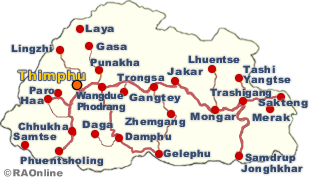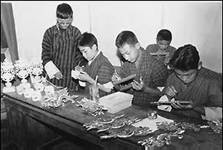| An
advocate for traditional art and craft |
 |
Bhutan People |
|
 |
Bhutan Information |
|
|
 |
| Traditional
art and craft might have found a strong advocate in Choki Dorji |
 |
Choki
Dorji started learning traditional painting at the age of 10 and never
forsook his brush even during his long tenure in the civil service. After
retiring from the High Court he fell back to his first love with a sense
of mission - to preserve and promote the art. "My life has completed a
circle; I began my life with painting and now I am back again in this old
world," said Choki Dorji. "I feel like a new man, reborn." For him, every
stroke of his brush is precious; every stroke embodies the colour of Bhutan's
identity, culture and tradition. |
And
he's determined to keep the "colours" glowing so that traditional arts
and crafts serve as a vehicle in promoting Bhutan's rich values.
"We must preserve our values and customs, our culture and tradition," he
emphasized, "This is one of our identities, if it disappears, it's gone
for ever."
In
his modest office in Kawajangsa, Thimphu, he unrolls a thangka of Mandala
and points out the flaws, which he says, was painted nonchalantly since
it was for sale. He noted: "I have seen foreigners taking great interest
and admiration in our paintings and other crafts, and more important, they
come to learn about our rich cultural heritage and the country through
them."
Since
the art goes out of the country, he said, every artist must endeavour to
make the best to ensure that the buyers discover the genuine satisfaction
and pleasure in owning those products. "We should leave no room for mediocrity,"
he added. The painting of religious symbols and figures is also seen as
merit-accumulating activities.
According
to Choki Dorji, he started learning traditional painting on the command
of the late King who had great interest in the traditional art and craft.
At the age of 14, he painted the new Tashichhodzong and was one of the
pioneers of the Painting School (now renamed as the Institute of Zorig
Chusum) at Kawajangsa in 1967. "I have been in traditional painting my
whole life and now, nearing the end of my life, my humble contribution
will be to pass the skills to the younger generation," he said. "I have
seen that there are no initiatives from the private sector to preserve
and promote our traditional art and crafts."
After
retiring from the High Court, he established Choki Handicrafts in 1993
with support from the Ministry of Trade and Industry and UNIDO/UNDP. It
is a small-scale enterprise specialising in traditional crafts such as
wood carving, weaving, painting, sculpturing, embroidery, basket ware,
and the manufacture of traditional furniture.
In
April 1999, Choki Traditional Art School was established, in keeping with
his aim to promote and preserve the intangibles that bind the cultural
integrity of the country.
 |
The school, at the moment, has about 25 students,
mainly from the poor families who cannot afford the modern education. It
has a prescribed syllabus for five years. The school does not charge any
fees although the school's financial position is shaky. However, there
is a glimmer of hope as their two-year knowledge starts taking shape in
the form of products that are sold through Choki Handicrafts. The money
is ploughed back to sustain the school. |
One
of the main problems faced by the school is space because of which not
many students can be admitted. But plans are afoot increase the capacity
so that at least 15 students graduate yearly. Because of his fanatical
zeal and on his insistence, Choki Dorji's daughter left school after class
XII to pursue her father's dream. "I want my whole family to get involved
in the preservation of the art," he asserted. "I am not doing business
and I am not interested in making money," claimed Choki Dorji. "But, I
will not leave the work undone.
 |
| This
article was contributed by KUENSEL, Bhutan's National Newspaper 2000 |
| more
information |
 |
|


